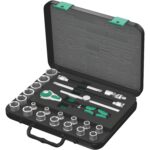The 1991 Toyota Land Cruiser FJ80, equipped with the venerable 3FE engine, is a legend in the off-road world. However, its diagnostic system can be a source of confusion for those accustomed to modern OBD2 standards. This article clarifies the diagnostic procedures for a 1991 FJ80 Land Cruiser 3FE.
While the 1991 FJ80 does not have an OBD2 port in the conventional sense, it does feature a diagnostic connector located in the engine bay. This connector, often a small gray box found at the back left corner, allows for retrieving diagnostic trouble codes (DTCs). Unlike OBD2 systems which provide detailed information via a scan tool, the 1991 FJ80 relies on a simpler system.
The primary method for extracting codes involves shorting specific terminals within the diagnostic connector and observing the flashes of the Check Engine Light (CEL). This process, often referred to as “blink codes,” requires a jumper wire and a reference chart to interpret the flashing sequences. Each series of flashes corresponds to a specific DTC, indicating a potential issue within the engine management system.
Common issues that might trigger a CEL in a 1991 FJ80 3FE include:
- Sensor Malfunctions: Issues with sensors like the oxygen sensor, coolant temperature sensor, or throttle position sensor can disrupt engine performance and trigger codes.
- Vacuum Leaks: Leaks in the intake manifold or vacuum hoses can lead to a lean fuel mixture and cause the CEL to illuminate.
- Wiring Problems: Damaged or corroded wiring can interrupt communication between sensors and the ECU, resulting in diagnostic codes.
- ECU Issues: While less common, problems with the Engine Control Unit (ECU) itself can lead to various driveability problems and trigger the CEL.
While a simple jumper wire can retrieve codes, more advanced diagnostic tools can provide additional insights. A multimeter, for example, can be used to measure voltages at various points in the system, aiding in pinpointing the source of a problem. Specialized OBD1 scan tools, although less common, are available for older Toyota models and can offer more detailed information than blink codes.
Troubleshooting a 1991 FJ80 3FE often involves a systematic approach:
- Retrieve Codes: Use a jumper wire to obtain the blink codes from the diagnostic connector.
- Consult Reference Material: Refer to a factory service manual or online resources to decipher the codes and understand the potential causes.
- Inspect Components: Visually inspect related components for obvious signs of damage, loose connections, or vacuum leaks.
- Test Components: Utilize a multimeter to test the functionality of suspected sensors and wiring.
- Address the Issue: Repair or replace faulty components as needed.
In conclusion, diagnosing a 1991 FJ80 Land Cruiser 3FE requires understanding its unique OBD1 system. Utilizing the diagnostic connector, a jumper wire, a reference chart, and a multimeter, owners can effectively troubleshoot and maintain these iconic vehicles. While lacking the sophistication of modern OBD2, the 1991 FJ80’s diagnostic system provides valuable information for addressing engine management issues.

